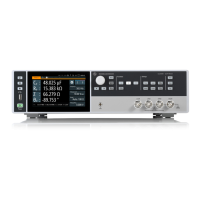Trying out the instrument
R&S
®
LCX Series
35Getting Started 1179.2254.02 ─ 03
b) Select the "Measurement" tab.
c) Select "Test Signal Level".
d) Select, e.g. "Voltage".
e) Confirm with "Set".
f) Press the [home] key to return to the measurement window.
The R&S LCX provides the selected parameter for the level setting on the
screen.
3. To set the test signal level:
a) On the screen, select "Level".
b) Enter, e.g. 1.3 VRMS.
c) Confirm with
.
4. If you know the expected range, set the range as follows.
Otherwise skip this step and proceed with step 5:
a) Select "Range".
b) In the "Select Measurement Range" dialog, select the expected impe-
dance, e.g. 10 kΩ.
c) Confirm with "Set".
5. On the front panel, press the [Auto] key to activate automatic detection of the
measurement function according to the component type of the DUT.
Aligning the instrument on all frequencies
To align the R&S LCX on all frequencies:
1. Press the [Comp.] key at the front panel.
The "Open/Short/Load Correction" dialog opens.
2. Perform a short correction, in this example described for the SMD test fixture
(R&S LCX-Z3):
a) Short-circuit the contact devices, i.e. the clamps or pins, according to the
used test fixture.
b) Set "Short Correction Enabled" > "ON".
The short correction takes about 2 minutes.
3. Perform an open correction:

